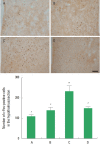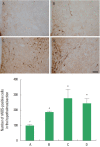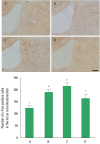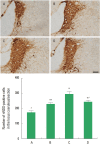Treadmill exercise alleviates stress-induced anxiety-like behaviors in rats
- PMID: 30443516
- PMCID: PMC6222149
- DOI: 10.12965/jer.1836442.221
Treadmill exercise alleviates stress-induced anxiety-like behaviors in rats
Abstract
Stress is the physiological responses of organisms to harmful or threatening stimuli that allow appropriate behavioral responses to the stressor. In the present study, the effect of treadmill exercise on stress-induced anxiety was evaluated using rats. To induce stress, the rats were exposed to an inescapable electric foot shock. Exposure of rats to the electric foot shock was performed for 7 days. The rats in the exercise groups were made to run on a motorized treadmill for 30 min once a day for 4 weeks stating one day after last electric food shock. Anxiety-like behaviors were determined by open field test and elevated plus-maze test. The expressions of c-Fos and neuronal nitric oxide synthase (nNOS) in the hypothalamus and locus coeruleus were detected by immunohistochemistry. In the present results, locomotor activity in the center of the open field test and the number of entries and time in the open arms of the elevated plus-maze test were reduced in the rats with stress-induced anxiety. Treadmill running enhanced these locomotor activities, the number of entries and time in the stress-induced anxiety rats. c-Fos and nNOS expressions in the hypothalamus and locus coeruleus were increased in the stress-induced rats. Treadmill exercise reduced c-Fos and nNOS overexpressions in the stress-induced rats. In the present study, treadmill exercise ameliorated anxiety-like behaviors in the stress-induced rats. The improving effect of treadmill exercise on anxiety-like behaviors might be ascribed to the suppressing effect of exercise on c-Fos and nNOS expressions.
Keywords: Anxiety; Neuronal nitric oxide synthase; Stress; Treadmill exercise; c-Fos.
Conflict of interest statement
CONFLICT OF INTEREST No potential conflict of interest relevant to this article was reported.
Figures





Similar articles
-
Treadmill exercise during pregnancy ameliorates post‑traumatic stress disorder‑induced anxiety‑like responses in maternal rats.Mol Med Rep. 2013 Feb;7(2):389-95. doi: 10.3892/mmr.2012.1197. Epub 2012 Nov 22. Mol Med Rep. 2013. PMID: 23174863
-
Effects of exercise on sexual function and central mechanism in the streptozotocin-induced diabetic rats.J Exerc Rehabil. 2018 Feb 26;14(1):10-15. doi: 10.12965/jer.1836072.036. eCollection 2018 Feb. J Exerc Rehabil. 2018. PMID: 29511647 Free PMC article.
-
Treadmill exercise alleviates post-traumatic stress disorder-induced impairment of spatial learning memory in rats.J Exerc Rehabil. 2013 Aug 31;9(4):413-9. doi: 10.12965/jer.130058. eCollection 2013. J Exerc Rehabil. 2013. PMID: 24278894 Free PMC article.
-
Effects of acute treadmill running at different intensities on activities of serotonin and corticotropin-releasing factor neurons, and anxiety- and depressive-like behaviors in rats.Behav Brain Res. 2016 Feb 1;298(Pt B):44-51. doi: 10.1016/j.bbr.2015.10.055. Epub 2015 Nov 2. Behav Brain Res. 2016. PMID: 26542811
-
Treadmill exercise alleviates stress-induced impairment of social interaction through 5-hydroxytryptamine 1A receptor activation in rats.J Exerc Rehabil. 2015 Aug 30;11(4):192-7. doi: 10.12965/jer.150225. eCollection 2015 Aug. J Exerc Rehabil. 2015. PMID: 26331133 Free PMC article.
Cited by
-
Maternal Inactivity Programs Skeletal Muscle Dysfunction in Offspring Mice by Attenuating Apelin Signaling and Mitochondrial Biogenesis.Cell Rep. 2020 Dec 1;33(9):108461. doi: 10.1016/j.celrep.2020.108461. Cell Rep. 2020. PMID: 33264618 Free PMC article.
-
Effect of high-intensity interval training on self-care and anxiety-like behaviors in naive rats.Exp Brain Res. 2024 Apr;242(4):913-920. doi: 10.1007/s00221-024-06793-z. Epub 2024 Mar 7. Exp Brain Res. 2024. PMID: 38451318
-
The zona incerta regulates burying behavior and normalizes anxiety-like behavior in inescapable stressful male mice by object cue.Neurobiol Stress. 2024 Dec 16;34:100704. doi: 10.1016/j.ynstr.2024.100704. eCollection 2025 Jan. Neurobiol Stress. 2024. PMID: 39991142 Free PMC article.
-
Treadmill exercise ameliorates nicotine withdrawal-induced symptoms.J Exerc Rehabil. 2019 Jun 30;15(3):383-391. doi: 10.12965/jer.1938228.114. eCollection 2019 Jun. J Exerc Rehabil. 2019. PMID: 31316930 Free PMC article.
-
Comparative overview of the effects of aerobic and resistance exercise on anxiety-like behavior, cognitive flexibility, and hippocampal synaptic plasticity parameters in healthy rats.Braz J Med Biol Res. 2020 Oct 9;53(11):e9816. doi: 10.1590/1414-431X20209816. eCollection 2020. Braz J Med Biol Res. 2020. PMID: 33053097 Free PMC article.
References
-
- Asmundson GJ, Fetzner MG, Deboer LB, Powers MB, Otto MW, Smits JA. Let’s get physical: a contemporary review of the anxiolytic effects of exercise for anxiety and its disorders. Depress Anxiety. 2013;30:362–373. - PubMed
-
- Berridge CW, Waterhouse BD. The locus coeruleus-noradrenergic system: modulation of behavioral state and state-dependent cognitive processes. Brain Res Brain Res Rev. 2003;42:33–84. - PubMed
-
- Borodovitsyna O, Flamini MD, Chandler DJ. Acute stress persistently alters locus coeruleus function and anxiety-like behavior in adolescent rats. Neuroscience. 2018;373:7–19. - PubMed
-
- Forestiero D, Manfrim CM, Guimarães FS, de Oliveira RM. Anxiolytic-like effects induced by nitric oxide synthase inhibitors microinjected into the medial amygdala of rats. Psychopharmacology (Berl) 2006;184:166–172. - PubMed
LinkOut - more resources
Full Text Sources

